 |
||
|
||
| ||
What do you think a video card starts with? The first thing catching your eye is a package. 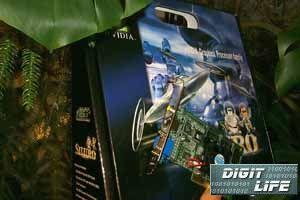 Look at the package for this video card! It's actually a big pasteboard box. It's so big that it can contain more than ten such boards but it's intended only for one - the ABIT Siluro GF2 MX. By the way, many users might remember impressive dimensions of the 3dfx Voodoo2 based video cards, especially there was leading the Quantum3D boards. Then, there came an epoch of Chinese video cards on the NVIDIA Riva TNT2M64 and S3 Savage4, which diminutiveness went hand in hand with low quality. Today, the NVIDIA GeForce2 MX based cards prove that reduced size does not necessary mean decreasing of quality and reliability. Moreover, the majority of the considered cards on this GPU possess good characteristics in all respects, in spite of small size. Well, let's at last turn to the board in question. Board
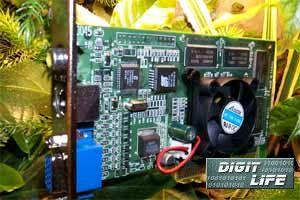 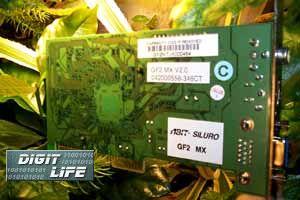  The card has the AGP 2x/4x interface, 32 MBytes 6 ns SDR SDRAM located in 4 chips on the right side of the PCB. The memory modules are produced by Hyundai. The default memory frequency constitutes 166 MHz. Well, let's come back to the size. So, the similarity with the Riva TNT2/TNT2M64 is evident, moreover, even the memory is of the same level (SDR). And there were some cases of sale of the Riva TNT2-based video cards under the guise of the GeForce2 MX. Some craftsmen installed there an outwardly modified BIOS, and a user was easily cheated. We have already discussed it and said that one sign of authenticity was called a reference design from NVIDIA, when all memory modules are located to the right from the GPU, and the PCB can be either narrow (without additional elements such as TV-out) or full-sized with a large area of blank space located above the memory modules. Analyzing the appearance of the ABIT Siluro GF2 MX you can easily notice that there are no traces of the NVIDIA reference design. So you shouldn't be afraid of the appearance of these boards which do not look similar as compared with many analogs on the GeForce2 MX. The PCB is green, it has a TV-out with both connectors: S-Video and RCA. The chip is equipped with a legacy active cooler. The complete set includes also the user's manual, CD with drivers and utilities (including DVD-player), and S-Video-extender. OverclockingWhat is a 6-ns memory? It means 30-50 MHz over the rated value. But note that memory overclocking possibilities can differ depending on a type and PCB design where the chips are installed. The experience show that the video cards based on the reference design have the best possibility in lifting memory frequencies. The given sample showed rather modest results - 190 MHz. And the GPU managed to leap over 220 MHz (from 175). Why are we talking about it in the last turn? Because NVIDIA marketing efforts made it to be unbalanced. That's why the GPU frequency hardly influence the overall performance where the main bottleneck is memory bandwidth. Installation and driversThe testbed is the following:
Together with the video cards ABIT ships drivers that are based on the NVIDIA reference ones and a little bit differing from the latter. Some attention should be paid to the Graphics MAX utility which is responsible for overclocking of the board. But apart these functions (which are also present in the reference drivers) there is nothing in the Graphics MAX.  Test resultsTraditionally we start with the 2D-graphics. Video cards are often blamed for bad image. But do not hurry to do it: first of all check that working frequencies of the monitor at the given resolution do not excess the rated. Besides, you should know monitors specs concerning quality support of the ultimate resolutions. Sometimes a definite video card doesn't suit some monitor. Sometimes, it might be a video card to blame for the bad quality of image. This concerns 2D-quality of the NVIDIA GeForce2 MX based video cards. The most such cards have it on quite a good level. But sometimes I come across exceptions. Some time ago I considered several video cards with defective 2D-graphics. Unfortunately, the ABIT Siluro GF2 MX having showed a perfect sharpness of image left the desktop striped. In the article on the Inno3D Tornado GeForce2 MX PCI I pointed at this defect in the form of vertical stripes 2 cm wide. Although the board in question have not so vivid stripes, they are still noticeable. With the following 2 games we will consider speed level in 3D-graphics:
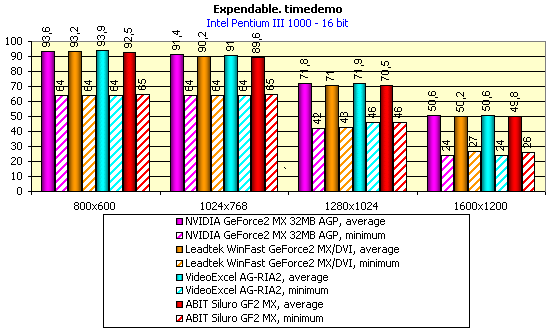  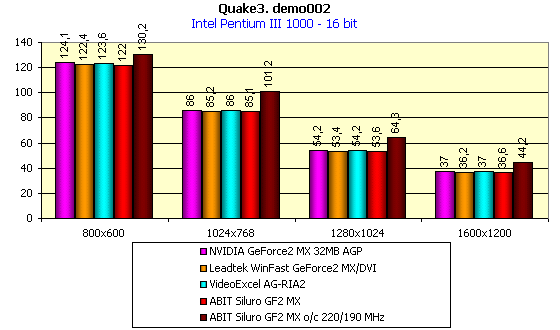 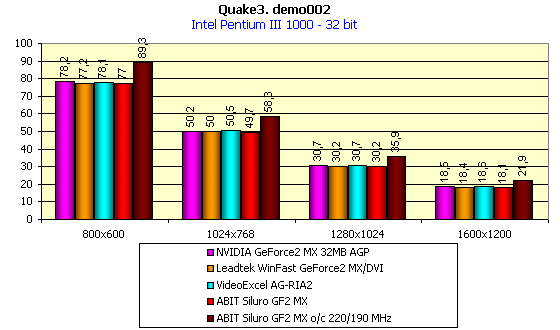 In performance this card doesn't differ from their sisters. Note that we overclocked this card just for the sake of interest, and these results can reflect the possible potential of other samples. The ABIT Siluro GF2 MX is equipped with a TV-out with two connectors that's why you can output the image on the TV. The TwinView technology allows to put an image on the TV and monitor at the same time and even to change the card's mode according to TwinView characteristics:
ConclusionWell, the ABIT Siluro GF2 MX video card is just another sample of ABIT which has entered the video card market not so long ago. The considered board on the GPU NVIDIA GeForce2 MX has shown stable operation, full correspondence of the parameters to the required characteristics despite the difference from the reference design. According to the test results, the card does not lag behind their analogs in performance. The card is supplied with a good complete set; at the same time it costs not much. Its downsides are defects in 2D-graphics in the form of vertical stripes. We have managed to get only one sample that's why I can't state that it's typical for all ABIT Siluro GF2 MX cards. Some users, though, said that they had faced such problems in 2D. Highs:
Lows:
Write a comment below. No registration needed!
|
Platform · Video · Multimedia · Mobile · Other || About us & Privacy policy · Twitter · Facebook Copyright © Byrds Research & Publishing, Ltd., 1997–2011. All rights reserved. |